Manhattan Plant Materials Center (KSPMC)
Serving areas in the States of Colorado, Kansas, Nebraska, and Oklahoma
Established: 1936
Size: 169 acres
PMC Operation: NRCS
Land Ownership: NRCS
 The Manhattan Plant Materials Center (KSPMC) develops plants and new plant technologies for America’s heartland. The Center offers services to a diverse region of the heartland including northeastern Colorado, Kansas, Nebraska, and northern Oklahoma. The Center is located on sandy loam soil in the Kansas River Valley, southwest of Manhattan, Kansas. The primary objective of the Center is to develop plant materials and technology for conservation innovation.
The Manhattan Plant Materials Center (KSPMC) develops plants and new plant technologies for America’s heartland. The Center offers services to a diverse region of the heartland including northeastern Colorado, Kansas, Nebraska, and northern Oklahoma. The Center is located on sandy loam soil in the Kansas River Valley, southwest of Manhattan, Kansas. The primary objective of the Center is to develop plant materials and technology for conservation innovation.
Plant and technology development objectives of the KSPMC include water quality improvement, increased water infiltration, erosion protection, range, and pasture improvement, Native American outreach, and plant development and production. The Center’s primary studies include work on long term storage of native seed, effect of long term seed storage on stand establishment, reclamation of disturbed sites, planting and harvesting native plants, and restoration of threatened and endangered native plant species.
The Center develops management and cultural techniques necessary for the establishment and acceptance of promising plant materials by the conservation community. The staff also produces limited quantities of breeder and foundation class seed or plants to stimulate commercial production of its releases.
The Manhattan Plant Materials Center has developed 30 improved conservation plants, including varieties of big bluestem, Indiangrass, switchgrass, aromatic sumac, purple prairie clover, and little bluestem.
Highlights
IMPROVE WATER QUALITY AND QUANTITY
Improve productivity and cover on critically damaged soils
- Kansas Technical Note (TN) 26: Plant Materials and Techniques for Brine Site Reclamation provides information from a literature search and a brine site reclamation study conducted by the Center.
- Revegetation of an exposed blue shale outcrop site in Jewel County, Kansas showed that common reed successfully grew and contained sediment on a site where natural slumping of rangeland exposed raw shale, creating a site where erosion was degrading downstream vegetation and water quality.
- Initiation of studies to provide Field Office’s with information on cover crop species composition, rate of seeding, date of planting and termination of various plant species at different times during the growing season. This data will provide producers with cover crop choices that will improve overall soil health and water quality within their individual farming system.
PROVIDE ACCESS FOR ALL TO THE PLANT MATERIALS PROGRAM
Increase the use of plants to address issues of human health, culture, and aesthetics
- Conserving the Heritage of Native Plants, a poster created by Plant Materials Centers in Colorado, Idaho, Kansas, Montana, and North Dakota, illustrates plants that have cultural significance for Native Americans.
- The Medicine Wheel/Circle is a brochure with a depiction of a Medicine Wheel produced at the KSPMC.
- Small acreage, limited resource farmers assisted with production of Chinese chestnut by a study to select for increased seed yield.
PROVIDE PLANTS AND TECHNOLOGY THAT ARE ECONOMICALLY FEASIBLE
Increase the use of specialized conservation plants to meet emerging needs
- KSPMC developed germination and propagation methodology for the federally threatened native plant species Mead’s milkweed. KSPMC worked with USFWS Marais des Cygnes National Wildlife Refuge to increase Mead’s milkweed population in Kansas.
- Propagation and Establishment of Mead’s Milkweed presented information at the Mead’s milkweed Symposium held at the University of Kansas.
- Mead’s milkweed – Easy to germinate, more difficult to establish transferred technology through the journal Ecological Restoration.
- Improving stand establishment and drought tolerance in sand bluestem through technology transfer in the Crop Science journal article Field Emergence and Plant Density of Sand Bluestem Lines Selected for Increased Seed Germination.
- Working with the group Monarch Watch to produced seed of two native milkweed species determined to be essential for the well being, survival, and long distance migration of native Monarch butterflies.
Manhattan Plant Materials Center
3800 S. 20th St.
Manhattan, KS 66502-9535
Telephone: 785-539-8761
Fax: 785-539-2034